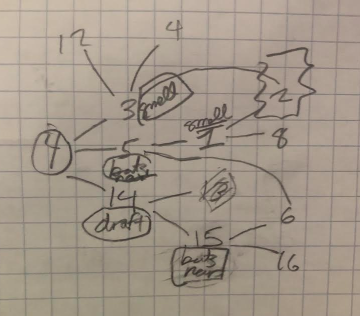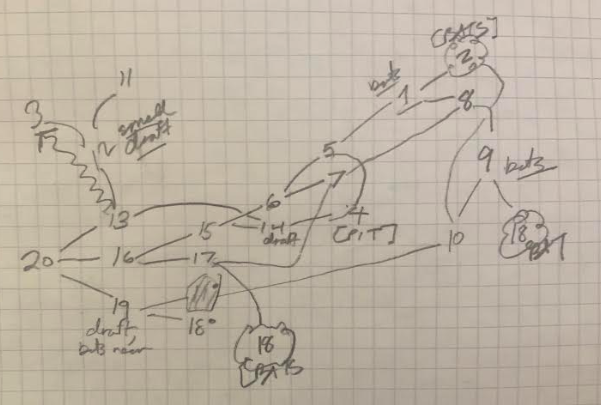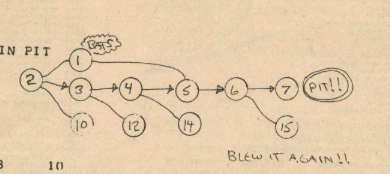
From PCC Nov. 1973.
I. The Frozen Man
Soon before he died, the author of Hunt the Wumpus adopted the name Gregory H. Coresun. His name before that was Hara Ra, one he took after becoming a shaman.
I perhaps should put “died” in quotes because his head is now cryogenically frozen at the Alcor Life Extension Foundation in Scottsdale.
He had some stories. For our story, we return to 1973, where he was Gregory Yob. To offer some continuity to his possible immortal self 1000 years from now when he reads this, I’ll call him Gregory.
II. The Game Itself
WELCOME TO ‘HUNT THE WUMPUS’
THE WUMPUS LIVES IN A CAVE OF 20 ROOMS.
EACH ROOM HAS 3 TUNNELS LEADING TO OTHER ROOMS.
Thus starts Gregory’s parvum opus. The 20 rooms are arranged in a “squashed dodecahedron” shape.

You have 6 arrows, and your goal is to hit the Wumpus with an arrow. In addition to the Wumpus itself being hazardous (it eats you if it is in the same room as you) there are bats which can randomly drop you in a new room and bottomless pits that can drop you to death.
If you are in a room adjacent to bats, you will get the message “BATS NEARBY!” Next to a bottomless pit, the game will say “I FEEL A DRAFT”. Next to the Wumpus, “I SMELL A WUMPUS.”
I FEEL A DRAFT
BATS NEARBY!
YOU ARE IN ROOM 1
TUNNELS LEAD TO 2 5 8SHOOT OR MOVE (S-M)? M
WHERE TO? 2
YYYIIIIEEEE . . . FELL IN PIT
HA HA HA – YOU LOSE!
As the game above illustrates, it’s sometimes possible to just get bad luck on a game setup and have to guess, just like in Minesweeper.
III. Strategy
Minesweeper is a good comparison; this is, in a way, a game of Minesweeper at the ground level. If you play carefully (and don’t get unlucky) it’s possible to chart via deduction where hazards are without stepping into them, and shooting the Wumpus without missing.
In practice, I tried more gambles than I needed to, just because it made the game flow better and was more fun. A sample game:

YOU ARE IN ROOM 4
TUNNELS LEAD TO 3 5 14SHOOT OR MOVE (S-M)? M
WHERE TO? 14I FEEL A DRAFT
YOU ARE IN ROOM 14
TUNNELS LEAD TO 4 13 15
I could actually be careful here, but since it was just the start of the game, I decided for a 50-50 gamble and went to room 15. Fortunately, the pit was in room 13 instead.
SHOOT OR MOVE (S-M)? M
WHERE TO? 15BATS NEARBY!
YOU ARE IN ROOM 15
TUNNELS LEAD TO 6 14 16
I know bats are in either rooms 6 or 16, but not which. Instead of taking another gamble, I went back to the start (room 4) to try a different direction.
SHOOT OR MOVE (S-M)? M
WHERE TO? 14I FEEL A DRAFT
YOU ARE IN ROOM 14
TUNNELS LEAD TO 4 13 15SHOOT OR MOVE (S-M)? M
WHERE TO? 4YOU ARE IN ROOM 4
TUNNELS LEAD TO 3 5 14SHOOT OR MOVE (S-M)? M
WHERE TO? 5BATS NEARBY!
YOU ARE IN ROOM 5
TUNNELS LEAD TO 1 4 6
Because I knew bats were in either room 6 or 16, and I sensed bats again while being adjacent to room 6, I decided to guess that 6 had the bats and 1 was safe. It could be that both rooms 16 and 1 had bats, so this was still a gamble, but a small one.
SHOOT OR MOVE (S-M)? M
WHERE TO? 1I SMELL A WUMPUS!
YOU ARE IN ROOM 1
TUNNELS LEAD TO 2 5 8SHOOT OR MOVE (S-M)? M
WHERE TO? 5BATS NEARBY!
YOU ARE IN ROOM 5
TUNNELS LEAD TO 1 4 6SHOOT OR MOVE (S-M)? M
WHERE TO? 4YOU ARE IN ROOM 4
TUNNELS LEAD TO 3 5 14SHOOT OR MOVE (S-M)? M
WHERE TO? 3I SMELL A WUMPUS!
YOU ARE IN ROOM 3
TUNNELS LEAD TO 2 4 12
There is only one Wumpus, so this last sequence was definitive: I smelled a Wumpus in either rooms 2 or 8, and in either rooms 12 or 2. This meant the Wumpus had to be in room 2.
SHOOT OR MOVE (S-M)? S
NO. OF ROOMS(1-5)? 1
ROOM #? 2
AHA! YOU GOT THE WUMPUS!
HEE HEE HEE – THE WUMPUS’LL GETCHA NEXT TIME!!
Part of the reason I was gambling when I didn’t have to is that bad luck isn’t just confined to the starting room; because the pits and bats serve as “blockers” of sorts on the map, it’s possible to land in a scenario later in the game where guessing is needed.

On the map above I had gotten to room 12 where I had both the “smell” and the “draft”. Every other route to those rooms was blocked, so I had to take a gamble. Fortunately, the arrows of the game can pass through multiple rooms, so I had a little bit of safety: I could take a step back to room 13, then try shooting an arrow all the way into 3 or 11 (passing through 12). If the arrow missed, the Wumpus would wake up, but at least I’d have another chance at killing him.
YOU ARE IN ROOM 13
TUNNELS LEAD TO 12 14 20SHOOT OR MOVE (S-M)? M
WHERE TO? 12I SMELL A WUMPUS!
I FEEL A DRAFT
YOU ARE IN ROOM 12
TUNNELS LEAD TO 3 11 13SHOOT OR MOVE (S-M)? M
WHERE TO? 13YOU ARE IN ROOM 13
TUNNELS LEAD TO 12 14 20SHOOT OR MOVE (S-M)? S
NO. OF ROOMS(1-5)? 2
ROOM #? 12
ROOM #? 3
AHA! YOU GOT THE WUMPUS!
HEE HEE HEE – THE WUMPUS’LL GETCHA NEXT TIME!!
SAME SET-UP (Y-N)? N
HUNT THE WUMPUS
IV. A Chain of Creativity
Last time, writing about Caves, I showed a list with a progression from Caves1 to Wumpus. The next issue of PCC was even more explicit:

PCC Sep. 1973.
According to Gregory himself, writing two years later in Creative Computing, the chains ran a little differently:
Two years ago I happened by People’s Computer Company (PCC) and saw some of their computer games — such as Hurkle, Snark, and Mugwump. My reaction was: “EECH!!” Each of these games was based set on a 10 x 10 grid in Cartesian coordinates and three of them was too much for me. I started to think along the line of: “There has to be a hide and seek computer game without that (exp. deleted) grid!!”” In fact, why not a topological computer game — Imagine a set of points connected in some way and the player moves about the set via the interconnections.
To summarize:
A. We started with an educational game (Hide and Seek) created in a classroom, using a Cartesian grid and the thin narrative of a hide-and-seek game.
B. The game directly caused the creation of a trio (Mugwump, Hurkle, Snark) involving the same grid, but only looking for a single point, and changing the narrative to “hunting” some sort of creature.
C. Alongside this came a game (Caves) based on the computer science construct of trees; it may have had some sideways educational motivation, but by putting the perspective “inside the data structure” the game turned into one of exploration that started to resemble the modern adventure game.
Hunt the Wumpus combines (B.) and (C.) and adds a fair number of innovations besides — arrows to take down the Wumpus, hazards, and the possibility the Wumpus wakes up.
Every current history of Wumpus only mentions the influence of the grid games, since Gregory didn’t write anything about Caves. I am not certain why the Creative Computing article left it out, but due to the survival of Gregory’s article surviving and the early PCC newspapers not being reprinted, Caves left the public consciousness almost entirely. (As far as I’ve been able to find, I’m the first to write about it since the 1970s.)

The same Creative Computing article includes a transcript with maps that look a lot like the “tree branching” of Caves.
Theory #1: Gregory was trying to write a condensed story, and he felt his particular insight and contribution had more to do with transferring the hide-and-seek setup to topologically constructed caves rather than the caves as a concept in theemselves.
Theory #2: Gregory was trying to take credit that was undeserved, that he was the inventor of “probably the first game to take place on a map consisting of rooms connected by passages.” (Quote by Magnus Olsson from a port of Wumpus.)
I’m fairly torn. Given he was only writing 2 years after the fact, it’d be hard to know just how historically important the game was, or what people would focus on (reading the article, it’s almost like he considers the dodecahedron the most interesting thing). It would also have been impossible to know just how thoroughly Caves would be wiped from the record. On the other hand, the text really gives the impression Gregory came up with the topologically-connected cave idea on his own. Substantiating this, Gregory wrote this in 2005, again leaving out any mention of Caves:
71 was a long time ago. Teletypes were the main interactive terminal, lucky people had “glass teletypes” which could hold 80 columns by 40 lines of text. games? nothing much – blackjack. or PCC’s litle edugames like mugwump and hurkle which were very simpleminded.
About the time I wrote Wumpus, a version of StarTrek came along, it wasn’t bad. Versions of aventure for CP/M personal computers came along 5 years later. You know, like using a pencil in pre calculator days, duh.
Star Trek came out in 1971; given that Mugwump and Hurkle weren’t even written until 1973 — and based on a game from 1972 — the chronology here is a bit off, which isn’t unusual regarding interviews with people about old mainframe games. Still, the “trying to tweak one’s historical legacy” warning flag is waving a bit.
If we take things all the way after his death (“death”?) his partner Andrea van de Loo wrote
He was the creator of the very first computer game, Hunt the Wumpus.
which sounds like the sort of exaggeration that came from Gregory himself. (Again, to be fair, most discussions of the early-70s computing era have a large number of inaccuracies — I’ve seen Hunt the Wumpus attributed to every year from 1971 to 1975 inclusive — so it’s possible she picked up this idea from somewhere else.)
Despite all that, I’m going to stick with Theory #1 for the moment; there just wasn’t enough motivation in 1975 to be revisionist about the connection with Caves, and with the other cases of this sort I can think of, there’s enough historical time gap it’s clear some fame was at stake (see, for example, Daniel Lawrence claiming he wrote DND “first” with no prior influence).
Even if there was a bit of historical omission involved, there is no denying Hunt the Wumpus became the most influential game out of PCC. It showed up not only in derivative versions (like Treasure Hunt) but in adventure games like Zork (referencing the superbats in the 1980 edition), Adventure 501 (where the Wumpus is an actual enemy you must run away from), and Hunter, In Darkness (an Andrew Plotkin game from 1999 which could be considered a remake).

The Wumpus is also now the mascot of Discord, the “modern voice & text chat app” designed for gamers.
Wumpus had two direct sequels (the first by Gregory himself, the second probably by Howie Franklin) which I’ll get to next time, and then I’ve got one more surprise to go before the Before Adventure series concludes.
For another Wumpus legacy, it shows up in nethack–apparently first as an optional monster in edition 2.3e from 1988. The Ranger Quest (starting in nethack 3.3.0, 1999) has a level based on Hunt the Wumpus, with interconnected cave rooms, giant bats, a couple of pit traps, and a wumpus, among other non-HtW monsters and traps.
Oh, looks like the Wumpus level of the Ranger Quest was introduced in version 3.3.0 in 2000.
3.3.1, dammit.
Great work. You are thoroughly reviewing adventures that are way less friendly than the ones of today. Honestly, I’d hardly consider hunt the wumpus an interactive fiction work, but hey, starts are hard…
Can you shoot through multiple rooms only along the sides of the middle pentagon where there are three rooms in a row, or can you do it through any arbitrary number as long as they’re connected? The article says “crooked arrows” so I suppose it lets you effectively shoot around corners.
Your maps look kind of tortured topologically! I would just start with the dodecahedron and number the points as I go.
You can shoot wherever as long as the rooms are connected.
If I was spending a long time on the dodecahedron it’d be worth getting the exact map down, but I didn’t play long enough for it to be worth it as I changed to Wumpus 2 (which has a bigger selection of maps).
The squashed dodecahedron is topologically uniform or whatever the term might be, isn’t it? By which I mean, you could take any five-cycle of rooms and draw it as the central pentagon, and then draw the five pentagons off each edge as the middle ring, and then the five caves not involved in any of those pentagons as the outer ring, and you’d get the same shaped map.
I enjoyed the version of Hunt the Wumpus that comes with Slackware Linux. Slackware also has the original Star Trek game, though I never got the hang of that one.
Pingback: Ross Codes: Hunt the Wumpus | A Mind Occasionally Voyaging
Only reading this now, a bit by coincidence (I was researching a company that did a “Hunt the Wumpus”-like). Great article !